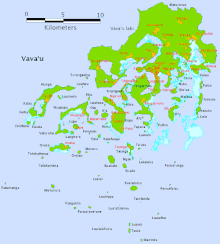Fishing Destination
Vavaʻu
 Map of Vava'u. | |
| Geography | |
|---|---|
| Location | Pacific Ocean |
| Coordinates | 18°39′S 173°59′W / 18.65°S 173.983°W |
| Archipelago | Tonga Islands |
| Total islands | 55 |
| Major islands | 1 |
| Area | 121 km2 (46.7 sq mi) |
| Highest elevation | 131 m (430 ft) |
| Highest point | Mount Talau |
| Country | |
Tonga
| |
| Largest city | Neiafu |
| Demographics | |
| Population | 15,505 (as of 2006) |
| Density | 128.14 /km2 (331.88 /sq mi) |
| Ethnic groups | Tongan (majority), European, Chinese, Pacific Islanders. |
- Vavau redirects here. For the village in Samoa, see Vavau, Samoa
Vavaʻu is a prime fishing destination with its beautiful harbour and untouched seas.
Myths and Legends
In Polynesia it is explained that the islands were created by the god Maui, that caught the bottom of the sea with his magic hook and left what became the islands of Vava'u. In total there are 70 islands, of which 17 are inhabited, spread over six districts.Geography
The Vava'u group measures about 21 km from east to west and 25 km from north to south. Vava'u had 15 485 inhabitants at the 2006 census total of 121 square kilometers. Well 3,900 lived in the capital Neiafu. The main island of Vava'u is 89.74 square kilometers, the second largest island in Tonga.Vavau is a coral reef with superior oblique in the north up to 200 m high cliffs. On the south side of the island group is dissolved into many small islands and waterways. The largest of these waterways, the fjord-like Ava Pulepulekai channel extends 11 km inland from the harbor of Neiafu, the capital. The Vava'u island is a raised platform of coral cliffs on the north coast and a low and irregular coastline south that opens in a complex network of channels, bays and islands forming one of the best protected natural harbors in the Pacific.
Vava'u is also home to the 'Ene'io Botanical Gardens, Tonga's only botanical garden.
Climate
Vava'u has a much warmer climate than the rest of Tonga excepting the Niua group of islands. Because of the island's warm climate and fertile soil, Vava'u is a haven for vanilla and pineapple growers as well as other tropical fruits.History
Don Francisco Antonio Mourelle was the first European to come to Vavaʻu, in February 1781. Captain James Cook knew about the island a decennium before, but the people in Haʻapai told him it would be no good for him to go there as there was no harbour. Apparently they did not want him to come, and Cook heeded their advice.But Mourelle found excellent anchoring, of which he was in desperate need after having failed on Fonualei (Bitterness island) and Late, and he gave the spot the name Port of Refuge. But his original Port of Refuge was the bay on the west coast of the main island, near Longomapu. In 1793 Alessandro Malaspina visited for a month, following up on Maurelle and claiming the islands for Spain.
Tuʻi Tonga George Tupou I instituted the Vavaʻu Code in Vavaʻu in 1839.
New island
In 2006, eruptions of the previously submarine volcano Home Reef caused it to rise above sea level, forming a new island to the southwest of the Vavaʻu archipelago.Governor
Hon. Luani was appointed as Governor of Vava'u in July 2009.[1] Governor Luani died suddenly on 12 May 2010.[2]Economy
Due to its scenic beauty Vava'u is particularly popular with sailors and other tourists and is one of the most important tourism centers in Tonga. From May to October, the Port of Vava'u welcomes sailing boats from all over the world where visitors can dive with birthing humpbacks and underwater caves.Tourism, agriculture and fishing are the main sources of income of the population. The vanilla grown here is one of the best in the world. Moreover, even giant clams and pearls are cultured.





No comments:
Post a Comment